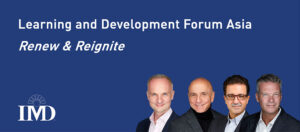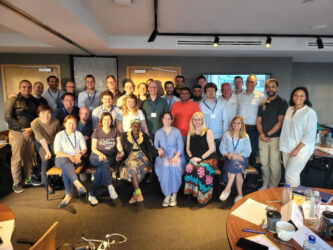Covid-19 has accelerated change in all areas like never before. Learning & Development (L&D) remains a key focus for organizations, and technology is transforming how programs are delivered. However, Covid-19 has drastically shortened the time frame for organizations to adopt digital transformation, and as they navigate the current crisis, ways of organizing work, skills and mindsets are being redefined.
The Institute for Management Development (IMD) recently brought together Learning and HR leaders in Asia, for its Learning and Development Forum Asia – Renew & Reignite, a two-day virtual event to explore the opportunities and challenges of managing learning in these unprecedented times.
Developing leaders in the digital age
Technology is transforming how learning programs are delivered. Moving to digital learning raises all sorts of questions, from how to ensure the impact and momentum of learning programs, to how online learning can be engaging, inclusive and participatory.
“Clearly the biggest challenge for companies has been moving to digital learning,” said Professor Misiek Piskorski, speaking at the event. “There are big issues around technology and connectivity, making digital learning stick, and in times of Zoom fatigue and competing demands on time, keeping engagement online.”
Another challenge for many organizations has been the need to create and adapt content for virtual learning, including live, pre-recorded and self-paced materials. Learning and HR leaders in Asia say they face issues with language barriers, translation costs and delays, global content that is not adapted to local needs and longer time needed to prepare and deliver learning initiatives. All this comes amid a continued preference for face-to-face learning, reduced budgets and capacity, and ever-growing expectations, said Professor Piskorski.
As learning goes digital, engagement online is critical. Online courses don’t have to be one-way lectures filled with endless PowerPoint slides. Using a blend of teaching tools and formats – podcasts, videos, consultations, virtual safaris, live plenaries, breakout groups, chats and opportunities to network – inspires people to participate, interact and connect with each other.
Organizations have had to adjust fast. “Many organizations have adapted their leadership development programs mainly through experimentation, by providing shorter offerings, using a variety of interactive online methods and focusing on immediate applications. Organizations have also opted for focus, centering their efforts on specific staff or skills set,” said Professor Piskorski.
The advantages technology can offer are clear. The question is how fast organizations can embrace digital transformation as they head into a fast-changing future.
Governance best practices
With business needs changing rapidly, good governance is crucial.
In a highly volatile business environment, it’s important to take a step back and ask whether current learning programs are still relevant, what outcomes are expected and what changes the organization wants to see.
Effective learning governance brings clarity to decision-making and ensures learning strategy aligns with overall business strategy.
Companies face important choices regarding the role of their learning governance, the form and structure these take, and the rules of engagement and membership.
Governance structure varies from one organization to the next and it is critical to align governance to the organizational learning model.
Learning governance plays an important role in taking ownership or advising in the areas of strategy, planning, financial stewardship, operational support, risk management and monitoring. Speaking at the forum, Professor Shlomo Ben-Hur introduced a governance framework for corporate learning.
When it comes to the learning board’s membership, it’s important to consider each member’s contribution to the board’s intellectual capital. “Think through the composition of the group, individual and team dynamics, tenure of members and consider bringing people onboard for varied periods” said Professor Ben-Hur.
The rules of engagement determine the annual calendar including how often groups meet and meeting agendas, how communication of information is managed and protocols for decision-making.
It’s also important to measure the performance of your company’s learning board, both at individual members level and as a collective by setting clear KPIs and establishing a process for review.
Integrating L&D with succession management
L&D plays an important role in succession management. As organizations look at their current and future talent bench, learning supports leadership progression by bridging the gap between the people an organization has today, and what it needs tomorrow.
At the forum, nearly half of respondents said succession planning activities remained unchanged as a result of Covid-19. Yet the world around us continues to change rapidly, with many companies having to diversify by repositioning their core business while at the same time creating new businesses at the edges.
“This dual transformation is the biggest challenge facing companies in Asia today” said Professor Richard Roi. “In these fast-changing times, organizations need to build teams that can drive transformation and win in the market.”
Leadership dialogues including competency-based interviews, psychometrics measuring personality and cognition, digital knowledge and experiences, line manager and 360 feedback are all valuable tools to assess succession candidates’ performance, leadership potential, role readiness and fit in the new normal.
Good leadership is a combination of knowledge, experience, behavior and personality. While the latter is difficult to undo altogether, effective learning programs help to acquire technical skills, gain professional experience and insights by achieving in relevant business areas, and build the behaviors needed to successfully perform in a leadership position.
“You’ll never find the perfect leader. There’s always a gap between what is ideal and the reality. Talent decision-making is about de-risking the appointment and looking at what skills are coachable and what further experience is needed” adds Professor Roi.
What businesses need today is durable leadership, characterized by thinking and behavioral agility as well as situational judgement to drive the dual transformation many organizations now face.
Scenario planning for a post-Covid world
More than ever, scenario planning is critical as it becomes increasingly difficult to predict the future with any certainty. Projecting where the world goes from here helps decision-making in all areas of business, including L&D.
Professor Michael Wade introduced a scenario planning tool to help participants think through what the world might look like going forward and what that means for their organizations.
As we navigate these times of high uncertainty, whatever the scenario – from the most optimistic to the most pessimistic – organizations will face opportunities and challenges. Even the most doom and gloom scenario will present new ways of doing business and growth opportunities.
Professor Wade said: “Scenario planning not only helps organizations generate creative ideas, but also solutions that are common among all scenarios. If an idea keeps coming up in all scenarios, it’s probably a good one!”
Never waste a good crisis, as the saying goes. “At the outbreak of the Covid pandemic, organizations were focused on ensuring business continuity, but now they must be proactive and seize opportunities around innovation and new growth. Now is the time to do it” said Professor Wade.
Renew and reignite
Now is the time to reimagine the future, from people to technology, in order to manage the now and be fit in the future. This is the right time to rethink learning to develop leadership that will help navigate and capitalize on the transition to a post-Covid world.



